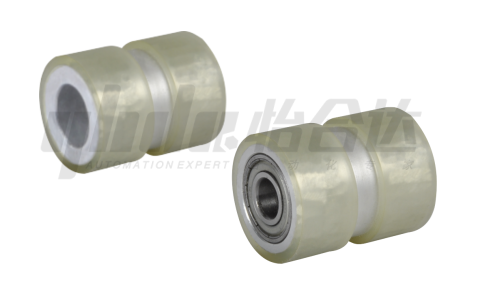Introduction
1. What is a rubber coated roller: A rubber-coated roller refers to a roller made of rubber material covering the core material. It is a common accessory in rolling transmission.
2. Why use rubberized rollers: Rubberized rollers have high hardness, excellent wear resistance, high elasticity even under high hardness, high surface finish, excellent grease resistance, and good chemical resistance. Can be used in harsh environments such as high and low temperatures, dryness and humidity.
3. The main function of the rubber-coated roller: it has high environmental adaptability.
(1) Improve transportation efficiency;
(2) Shock absorption and product protection;
(3) Reduce noise;
(4) Reduce oil pollution;
(5) High environmental adaptability
Types and Applications of Rubber Coated Rollers
1. Bearing type:
Suitable for linear conveying motion
(Polyurethane, nitrile rubber, silicone rubber materials can be selected)
Roller Bearing Type
2. Grooved type:
Use with belt for clamping or sliding
(Trough size can be customized according to different belt sizes)
Roller Groove Type
3. Piping type:
Different length options can be used in equipment for rolling or conveying.
Roller Piping Type
4. Ring type:
Used with shafts for fixed rotation conveying

5. Type with set screw:
Use screws to fix on the shaft
Can be used for clamping, extruding or pasting
(optional high temperature resistant (120℃) polyurethane material)
Roller Set Screw Type
6. Threaded hole pattern:
It should be fixed on the shaft with screws and can be used for fixed rotation and transportation.

7. Type with keyway:
Use key slots or add screws to fix
Improve operational load-bearing and torque resistance capabilities
Suitable for high-load conveying, guiding, rolling, etc.
(Anti-static polyurethane material optional)
Roller Keyway Type
8. Ladder type:
Step + screw fixing design
Suitable for embedded installation of baffles, which can be used for longitudinal and transverse conveying or guiding functions
Roller Ladder Type
Analysis of Materials and Characteristics of Rubber Coated Rollers
Polyurethane material:
1) Excellent wear resistance
2) Extremely high mechanical strength
3) Good surface self-lubrication
4) High elasticity coefficient
Silicone rubber material:
1) Excellent low temperature resistance (-70℃)
2) Excellent high temperature resistance (150℃)
3) Good weather resistance
4) Low wear resistance and mechanical strength
NBR material
1) Excellent grease resistance
2) Good wear resistance
3) Limited resistance to chemical corrosion, acid and alkali resistance
4) Poor temperature resistance (high temperature 80℃, low temperature -10℃)
Hypalon material
1) Excellent ozone resistance
2) High weather resistance
3) Better solvent resistance, acid and alkali resistance
4) Poor tear resistance and low mechanical strength
EPDM material
1) Extremely strong corrosion resistance
2) Extremely strong chemical resistance
3) Extremely weather resistant
4) Excellent hydrolysis resistance
5) Limited resistance to grease
Selection of Working Conditions for Rubber Coated Rollers
Working condition 1: High-strength and high-wear working conditions
Choice: High wear-resistant A90-degree or 95-degree polyurethane (PU) rollers.
Working condition 2: Harsh high or low temperature working conditions
Choice: silicone rubber (SI) roller (can be used in -70℃~150℃).
Working condition 3: Working conditions with both temperature requirements and wear resistance
Choose: Heat-resistant polyurethane (PU) roller (can be used in -20℃~120℃).
Working condition 4: Corrosive working conditions
Choice: EPDM roller.
Working condition 5: Humid and long-term contact with water
Choice: EPDM roller.
Working condition 6: Anti-static working condition requirements
choose:
①〈Both anti-static properties and wear resistance are required〉Choose anti-static polyurethane (PU) rollers;
②〈Permanent anti-static performance〉Choose anti-static rollers made of silicone or rubber.
Working condition 7: Acidic, alkaline and ozone working conditions
Choose: Hypalon Roller.
In addition, there are still many very complex working conditions that need to be solved, but it doesn't matter. We can provide technical support for special and complex working conditions, conduct material property analysis and research and development, and provide professional technical solutions.











